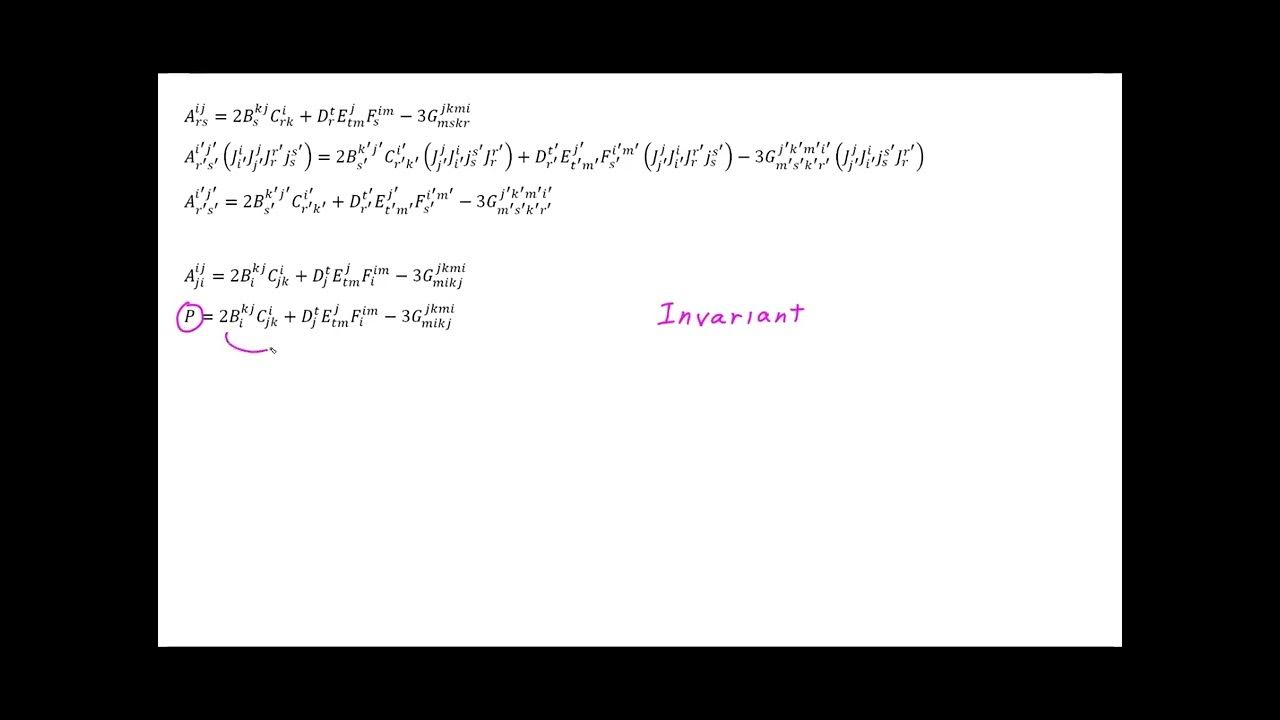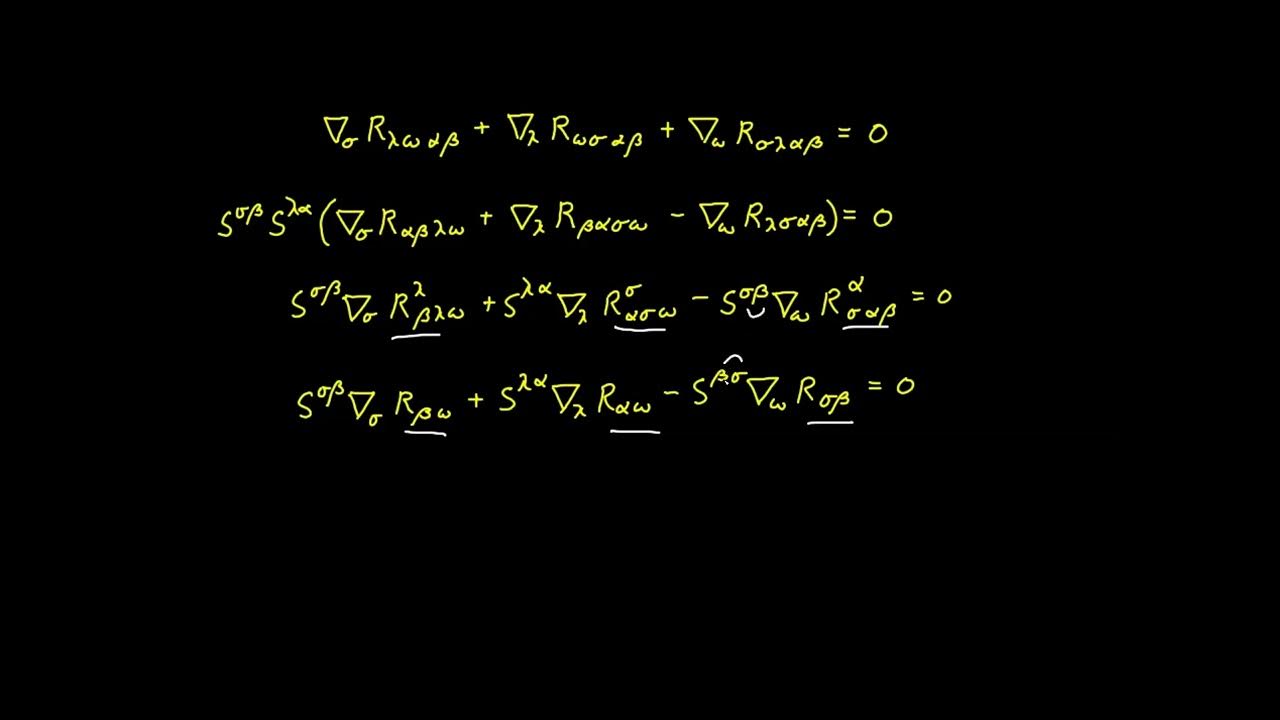Video 01 - Why Tensor Calculus
TLDRIn this introductory video on tensor calculus, Jim Fowler aims to demystify and elucidate the subject, emphasizing its significance in presenting physics equations in a coordinate-independent manner. Fowler discusses the historical development of tensor calculus, its geometric foundations, and its utility in avoiding the pitfalls of premature coordinate system selection. He also highlights the contributions of mathematicians like Riemann, Ricci, and Einstein, and recommends prerequisites for understanding the series, suggesting Grenfell's 'Introduction to Tensor Analysis' as a valuable resource.
Takeaways
- 📚 Tensor calculus is an extension of vector calculus to tensor fields, allowing for the presentation of physics equations in a coordinate-independent form.
- 🌐 The strength of tensor calculus lies in its ability to express geometric relationships as tensor equations, which remain invariant regardless of the coordinate system used.
- 🔍 The script emphasizes the importance of understanding geometric principles for a thorough comprehension of physical phenomena, which tensor calculus helps to achieve.
- 📈 The historical development of tensor calculus is highlighted, with contributions from mathematicians such as Riemann, Ricci, and Einstein, showing its significance in the field of mathematics and physics.
- 📉 The video script illustrates the limitations of using specific coordinate systems too early in problem-solving, which can obscure the geometric nature of a problem and lead to unnecessary complexity.
- 📚 The educational goal of the video series is to share knowledge of tensor calculus to help viewers gain an appreciation for its applications in mathematics and physics.
- 📐 The script provides a historical context for the development of tensor calculus, including its roots in differential geometry and its evolution through the contributions of various mathematicians.
- 📘 The video series is structured to follow the approach of the book 'Introduction to Tensor Analysis' by Grenfell, which is recommended for those interested in a deeper understanding of the subject.
- 🔑 The prerequisites for understanding tensor calculus include a solid foundation in algebra, trigonometry, calculus, and familiarity with topics like analytical geometry, vector analysis, and linear algebra.
- 🚫 The script clarifies that knowledge of physics or general relativity is not required to understand tensor calculus, as the focus is purely on the mathematical aspects.
- 💡 The central idea of tensor calculus is to acknowledge the need for coordinate systems while avoiding commitment to a specific system for as long as possible, providing a universal method for constructing analytical expressions.
Q & A
What is the main purpose of tensor calculus according to the video?
-The main purpose of tensor calculus is to allow the presentation of physics equations in a form that is independent of the choice of coordinates on a manifold, which helps in understanding and solving problems in a coordinate-free manner.
What is the significance of presenting physics equations in a coordinate-independent form?
-Presenting physics equations in a coordinate-independent form is significant because it reveals the underlying geometric nature of the problem and avoids the complexity that can arise from choosing the wrong coordinate system.
What is the historical context of tensor calculus mentioned in the video?
-The historical context mentioned in the video includes the contributions of mathematicians like Bernhard Riemann, Gregorio Ricci-Curbastro, Tullio Levi-Civita, Marcel Grossmann, and Albert Einstein, who played crucial roles in the development and application of tensor calculus.
What is the role of coordinate systems in tensor calculus?
-Coordinate systems in tensor calculus are used to derive quantitative results, but the ultimate goal is to express these results in a way that is invariant under changes of coordinates, thus revealing the geometric essence of the problem.
Why is it important to understand the geometric principles in physical phenomena?
-Understanding geometric principles is important because it provides a robust set of mathematical tools to work with, allowing for a more profound comprehension of the physical world and the relationships observed within it.
What is the difference between tensor calculus and vector calculus?
-Tensor calculus is an extension of vector calculus that deals with tensor fields instead of just vectors. It allows for the representation of physical laws in a more general and coordinate-independent manner.
What is the role of tensors in the context of the video?
-Tensors play a crucial role as they are the fundamental objects in tensor calculus, used to express and analyze geometric relationships in a coordinate-independent way.
What is the importance of choosing the right coordinate system in problem-solving?
-Choosing the right coordinate system is important because it can simplify the analytical expressions and reveal the geometric nature of the problem, avoiding unnecessary complexity and potential errors.
What does the video suggest as the best approach to mathematical problem-solving?
-The video suggests that the best approach to mathematical problem-solving is to perform analysis at the highest level of abstraction possible and only move to lower levels of abstraction when absolutely necessary.
What are the prerequisites for understanding the content of the video?
-The prerequisites for understanding the content of the video include a solid foundation in algebra, trigonometry, basic calculus, and ideally some experience with analytical geometry, vector analysis, differential equations, and linear algebra.
What book is recommended in the video for further study of tensor calculus?
-The book recommended in the video for further study of tensor calculus is 'Introduction to Tensor Analysis' by Grenfell, which is praised for its clear structure and reasonable sequencing of topics.
Outlines
📚 Introduction to Tensor Calculus
Jim Fowler introduces a series of videos on tensor calculus, expressing his passion for the subject and its significance in mathematics. He aims to share his knowledge to foster appreciation for tensor calculus. The video begins by addressing the fundamental questions about what tensor calculus is, its applications, and its benefits. Fowler emphasizes the strength of tensor calculus in presenting physics equations independently of coordinate choices, which is crucial for scientific modeling. He also discusses the importance of understanding geometric principles and having robust mathematical tools, such as tensor calculus, to analyze physical phenomena.
📐 The Power of Coordinate Systems in Geometry
This paragraph delves into the historical progression of mathematical understanding from basic algebra and Euclidean geometry to the introduction of coordinate systems, leading to analytic geometry. Fowler shares his fascination with the discoveries made in geometry without a coordinate system, exemplified by the Pythagorean theorem. He then contrasts this with the analytical capabilities enabled by coordinate systems, such as calculating midpoints, lengths, areas, and working with curves and surfaces in multiple dimensions. The paragraph also touches on the representation of vectors and operations in differential calculus and vector analysis, highlighting the importance of choosing the right coordinate system to avoid obscuring the geometric nature of problems.
🔍 The Importance of Abstraction in Mathematics
Fowler discusses the principle of performing mathematical analysis at the highest level of abstraction before moving to lower levels when necessary. He uses historical examples involving Leonard Euler, Joseph Lagrange, and Jean Baptista Monge to illustrate how choosing the wrong coordinate system can obscure the geometric significance of solutions. The paragraph emphasizes the importance of recognizing the geometric nature of mathematical objects as invariants and the pitfalls of relying too heavily on specific coordinate systems. Fowler reinforces the idea with a problem involving minimal surfaces and the mean curvature tensor, showing how tensor calculus can simplify complex problems.
📘 The Evolution of Tensor Calculus
This section provides an overview of the major contributors to the development of tensor calculus. Bernard Riemann, Elwin Bruno Christophel, Gregorio Ricci-Curbastro, Tulio Levy-Cevita, Marcel Grossman, and Albert Einstein are highlighted for their significant contributions to the field. The paragraph traces the evolution of tensor calculus from its roots in differential geometry to its formal establishment by Ricci-Curbastro and its application in Einstein's general theory of relativity. The narrative underscores the impact of these mathematicians on the advancement of tensor calculus and its role in modern physics.
📚 Prerequisites and Resources for Learning Tensor Calculus
Fowler outlines the prerequisites for understanding tensor calculus, suggesting a strong foundation in algebra, trigonometry, calculus, analytical geometry, vector analysis, differential equations, and linear algebra. He clarifies that while a background in these areas is beneficial, it is not strictly necessary, as the focus is on mathematics rather than science or physics. He also recommends a book by Grenfell on tensor analysis, which he will be using as a guide for the video series, and emphasizes that the series is about mathematics and not about science, making it accessible to a broader audience.
🎯 The Central Idea of Tensor Calculus
The final paragraph wraps up the video with a central takeaway: the essence of tensor calculus is to acknowledge the need for coordinate systems while avoiding commitment to a specific system for as long as possible. Tensor calculus provides algorithms for constructing analytical expressions that are valid across all coordinate systems, thus maintaining the geometric integrity of solutions. Fowler ends with a quote from Grenfell's book that encapsulates the rationale behind tensor calculus, setting the stage for the next video, which will review the properties of Euclidean space.
Mindmap
Keywords
💡Tensor Calculus
💡Manifold
💡Tensor Field
💡Coordinate System
💡Geometric Objects
💡Analytic Geometry
💡Differential Equation
💡Euclidean Geometry
💡Invariant
💡General Relativity
💡Einstein
Highlights
Introduction to tensor calculus as an extension of vector calculus to tensor fields.
Tensor calculus allows physics equations to be presented in a coordinate-independent form.
Importance of geometric principles in understanding physical phenomena and the role of tensor calculus.
The historical progression from Euclidean geometry to analytic geometry with coordinate systems.
Examples of geometric discoveries made without a coordinate system, such as the Pythagorean theorem.
Demonstration of how coordinate systems can simplify calculations of midpoints, lengths, and areas.
Introduction of curves and surfaces in analytic geometry through equations.
Parameterization of coordinates to describe curves and surfaces in three dimensions.
Vector operations in a coordinate system, including decomposition and resultant vectors.
Differential calculus and vector analysis expressed in Cartesian coordinates versus spherical polar coordinates.
The concept of geometric objects as invariants, independent of the coordinate system used.
The potential pitfalls of choosing the wrong coordinate system early in problem-solving.
Historical example of minimal surfaces and the impact of coordinate system choice on understanding.
The principle of performing analysis at the highest level of abstraction before moving to lower levels.
Examples illustrating the advantages of simplifying functions to reveal underlying relationships.
Introduction to the major contributors to tensor calculus, including Riemann, Ricci, and Einstein.
Prerequisites for understanding tensor calculus, emphasizing algebra, trigonometry, and calculus.
Recommendation of a book for further study: 'Introduction to Tensor Analysis' by Grenfell.
Final takeaway emphasizing the central idea of tensor calculus to avoid premature coordinate system selection.
Transcripts
5.0 / 5 (0 votes)
Thanks for rating:





